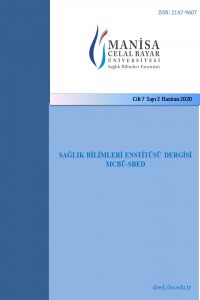Kalp Damar Cerrahisi Yoğun Bakım Hemşirelerinde Şefkat Yorgunluğu ve Etkileyen Faktörlerin Belirlenmesi
Öz
Amaç; Şefkat yorgunluğu acı çeken bireylere harcanan yoğun bedensel ve duygusal güçten dolayı hastadan duygusal olarak uzaklaşmadır. Bu çalışma kalp damar cerrahisi yoğun bakım ünitesinde (KDC YBÜ) çalışan hemşirelerde şefkat yorgunluğunu ve etkileyen faktörleri belirlemek amacıyla yapıldı.
Gereç ve Yöntem; Tanımlayıcı tipteki bu çalışmanın örneklemini İstanbul’da bulunan özel bir sağlık grubuna ait beş hastane ve İzmir’de bulunan bir üniversite hastanesinin KDC YBÜ birimlerinde çalışmakta olan 76 hemşire oluşturdu. Veriler Nisan- Temmuz 2016 tarihleri arasında sosyodemografik veriler ve Çalışanlar için Yaşam Kalitesi Ölçeği ile toplandı. Çalışmanın sürdürülebilmesi için gerekli izinler alındı.
Bulgular: Hemşirelerin Şefkat Yorgunluğu alt boyutundan aldıkları puanlar 0 ile 38 arasında değişmekte olup, ortalamasının 16,86±8,54 olduğu belirlendi. Hemşirelerin yaş, cinsiyet, medeni durum, eğitim durumu, çocuk sahibi olma durumu, çalışma süresi, bir şiftte ortalama bakım verilen hasta sayısı ve işini sevme durumlarına göre şefkat yorgunluğu puanları arasında istatistiksel olarak anlamlı bir farklılık bulunmadı (p>0,05). Düzensiz meslek içi eğitim alan hemşirelerin şefkat yorgunluğu alt boyutu puanları, düzenli meslek içi eğitim alan hemşirelerden istatistiksel olarak anlamlı düzeyde yüksek bulundu (p:0,025; p<0,05).
Sonuç; Çalışma kapsamında KDC YBÜ hemşirelerinin şefkat yorgunluğu düzeyleri orta olup düzenli hizmet içi eğitim almanın şefkat yorgunluğu gelişimini önlemede önemli olduğu belirlendi. Hemşirelerde şefkat yorgunluğu gelişimini önlemek için eğitim, danışmanlık ve destek programları yapılması önerilmektedir.
Anahtar Kelimeler
Destekleyen Kurum
BULUNMAMAKTADIR
Proje Numarası
BULUNMAMAKTADIR
Teşekkür
-
Kaynakça
- 1. Cornwell, J. and J. Goodrich, Ensuing Compassionate Care in Hospital. Nursing Times Ethical, 2009: p. 7-9.
- 2. Uslu, Y. and F. Demir Korkmaz, Yoğun Bakımda Hemşirenin Hissi Tarafı “Şefkat” ve Bakım. Yoğun Bakım Hemşireliği Dergisi, 2016. 20(2): p. 108-115.
- 3. Uslu, Y. and F. Demir Korkmaz, Hemşirenin Hissi Tarafı Şefkatin Bedeli: Şefkat Yorgunluğu. Ege Üniversitesi Hemşirelik Fakültesi Dergisi, 2017. 33(1): p. 123-133.
- 4. Figley, C.R., Compassion fatigue: Coping with secondary traumatic stress in those who treat the traumatized. 1995: Brunner/Mazel, Publishers.
- 5. Coetzee, S.K. and H.C. Klopper, Compassion fatigue within nursing practice: A concept analysis. Nursing & health sciences, 2010. 12(2): p. 235-243.
- 6. Schroeter, K., Compassion fatigue: An unwanted reflection of your reality. 2014, LWW.
- 7. Hooper, C., et al., Compassion satisfaction, burnout, and compassion fatigue among emergency nurses compared with nurses in other selected inpatient specialties. Journal of emergency nursing, 2010. 36(5): p. 420-427.
- 8. Wakefield, E., Compassion fatigue in the perioperative environment. Journal of Perioperative Nursing, 2018. 31(2): p. 21.
- 9. Young, J.L., et al., Compassion satisfaction, burnout, and secondary traumatic stress in heart and vascular nurses. Critical care nursing quarterly, 2011. 34(3): p. 227-234.
- 10. Van Mol, M., et al., The prevalence of compassion fatigue and burnout among healthcare professionals in intensive care units: a systematic review. PloS one, 2015. 10(8): p. e0136955.
- 11. Kelly, L., J. Runge, and C. Spencer, Predictors of compassion fatigue and compassion satisfaction in acute care nurses. Journal of Nursing Scholarship, 2015. 47(6): p. 522-528.
- 12. Alkema, K., J.M. Linton, and R. Davies, A Study of the Relationship Between Self-Care, Compassion Satisfaction, Compassion Fatigue, and Burnout Among Hospice Professionals. Journal of Social Work in End-of-Life & Palliative Care, 2008. 4(2): p. 101-119.
- 13. Abendroth, M. and J. Flannery, Predicting the risk of compassion fatigue: A study of hospice nurses. Journal of Hospice and Palliative Nursing, 2006. 8(6): p. 346-356.
- 14. Sacco, T.L., et al., Compassion satisfaction and compassion fatigue among critical care nurses. Critical care nurse, 2015. 35(4): p. 32-42.
- 15. Yu, H., A. Jiang, and J. Shen, Prevalence and predictors of compassion fatigue, burnout and compassion satisfaction among oncology nurses: A cross-sectional survey. International Journal of Nursing Studies, 2016. 57: p. 28-38.
- 16. Stamm, B. The concise manual for the professional quality of life scale. ProQOL.org ,Pocatello, ID 2010.
- 17. Yeşil, A., et al., Çalışanlar İçin Yaşam Kalitesi Ölçeği Türkçe Uyarlaması Geçerlik ve Güvenilirlik Çalışması. Archives Of Neuropsychiatry/Noropsikiatri Arsivi, 2010. 47(2).
- 18. Hall, D.S., Work-related stress of registered nurses in a hospital setting. Journal for Nurses in Staff Development, 2004. 20(1): p. 6-14.
- 19. Yoder, E.A., Compassion fatigue in nurses. Applied nursing research, 2010. 23(4): p. 191-197.
- 20. Kim, S.Y., Compassion fatigue in liver and kidney transplant nurse coordinators: A descriptive research study. Progress in Transplantation, 2013. 23(4): p. 329-335.
- 21. Zhang, Y.Y., et al., Extent of compassion satisfaction, compassion fatigue and burnout in nursing: A meta‐analysis. Journal of nursing management, 2018. 26(7): p. 810-819.
- 22. Mangoulia, P., et al., Prevalence of secondary traumatic stress among psychiatric nurses in Greece. Archives of psychiatric nursing, 2015. 29(5): p. 333-338.
- 23. Hegney, D.G., et al., Compassion satisfaction, compassion fatigue, anxiety, depression and stress in registered nurses in A ustralia: study 1 results. Journal of nursing management, 2014. 22(4): p. 506-518.
- 24. Denk, T. and Ç. Köçkar, Compassion fatigue in nurses working in surgical clinics. Yaşam Becerileri Psikoloji Dergisi, 2018. 2(4): p. 237-245.
- 25. Paige L, B. and S. Jaynelle F, Nursing work environment and nurse caring: relationship among motivational factors. Journal of Advanced Nursing, 2010(8): p. 1819.
- 26. Kolthoff, K.L. and S.E. Hickman, Compassion fatigue among nurses working with older adults. Geriatric Nursing, 2017. 38(2): p. 106-109.
- 27. Bitek, D. and A. Akyol, Yoğun bakım hemşı̇relerı̇nı̇n çalışma ortamına ilişkin algıları ile iş doyumları arasındakı̇ ilişkinin ıincelenmesi. Yoğun Bakım Hemşireliği Dergisi, 2017. 21(1): p. 1-6.
Ayrıntılar
| Birincil Dil | Türkçe |
|---|---|
| Konular | Hemşirelik |
| Bölüm | Araştırma Makalesi |
| Yazarlar | |
| Proje Numarası | BULUNMAMAKTADIR |
| Yayımlanma Tarihi | 30 Haziran 2020 |
| Yayımlandığı Sayı | Yıl 2020 Cilt: 7 Sayı: 2 |


